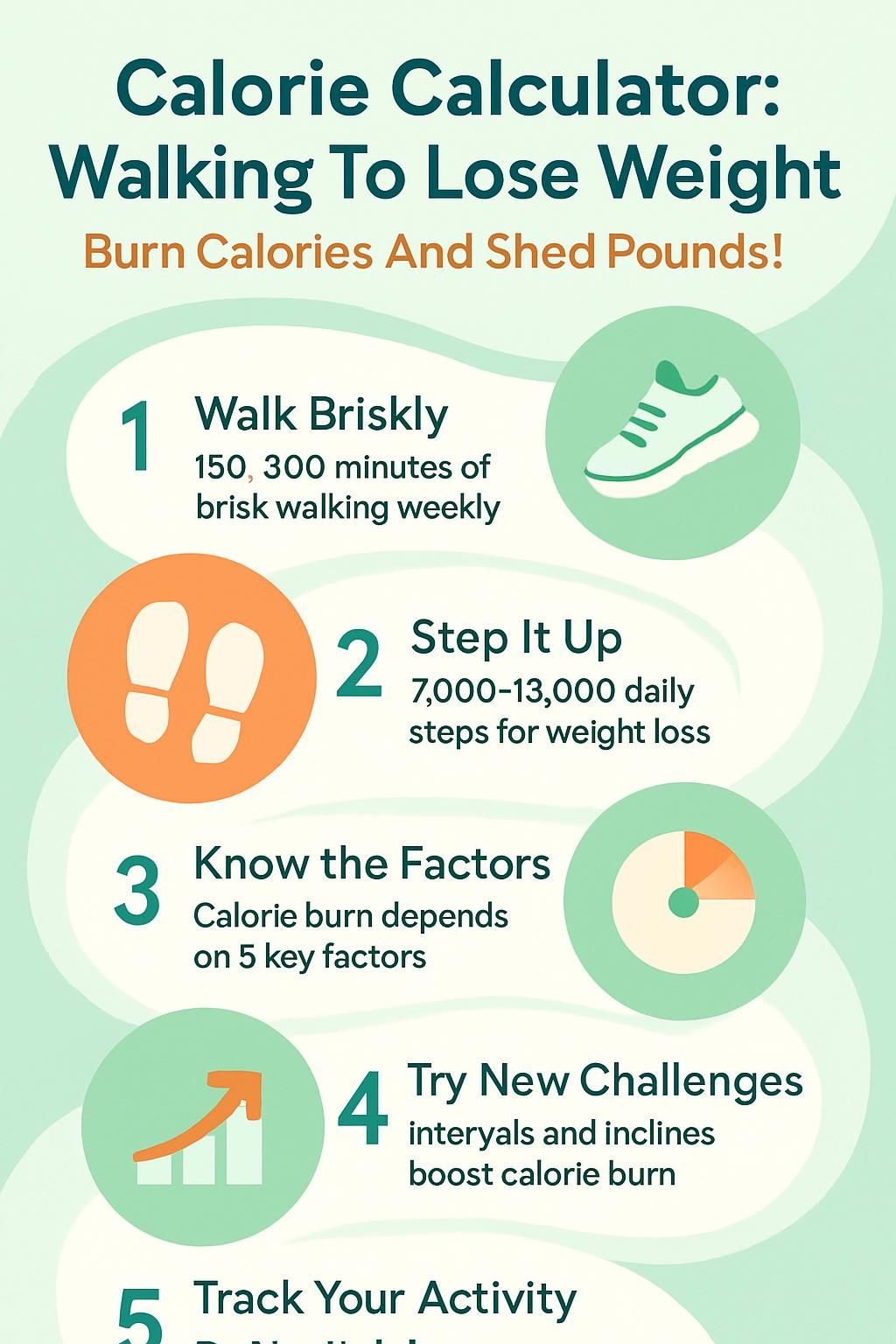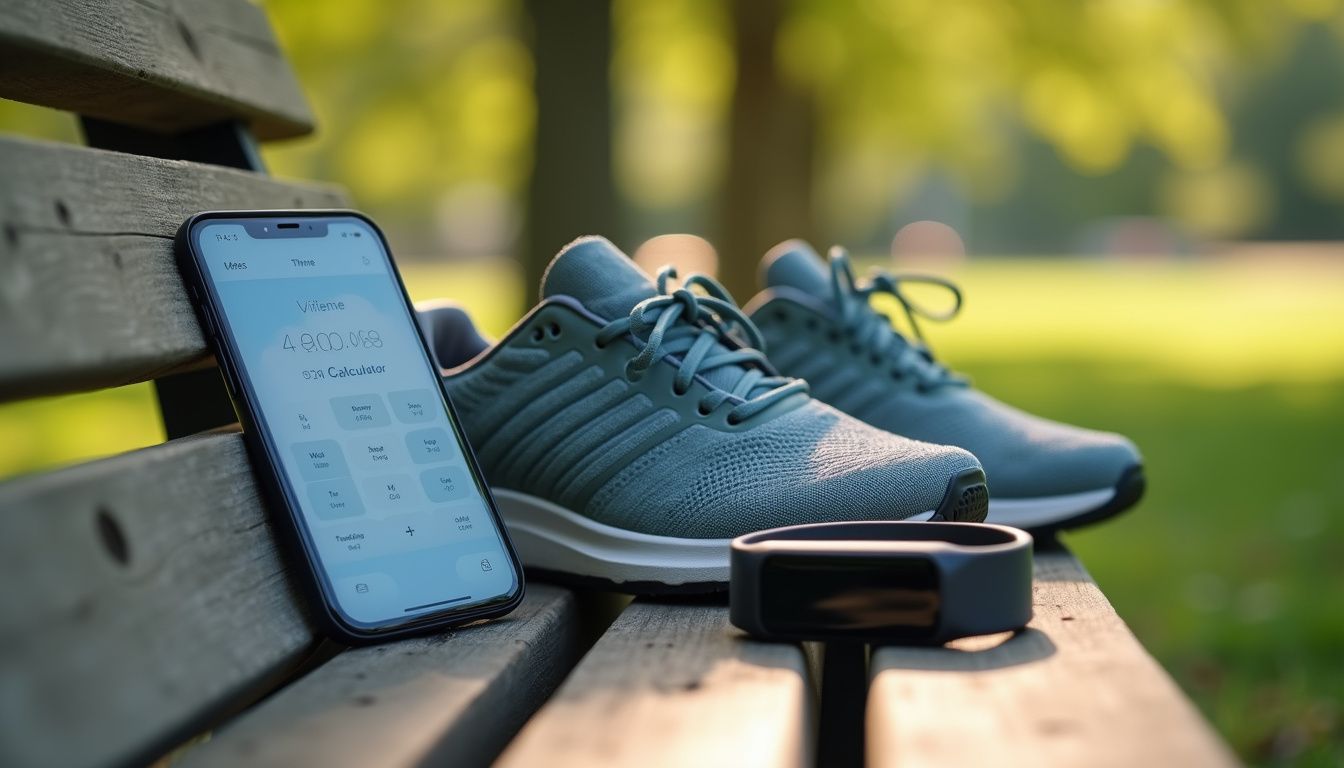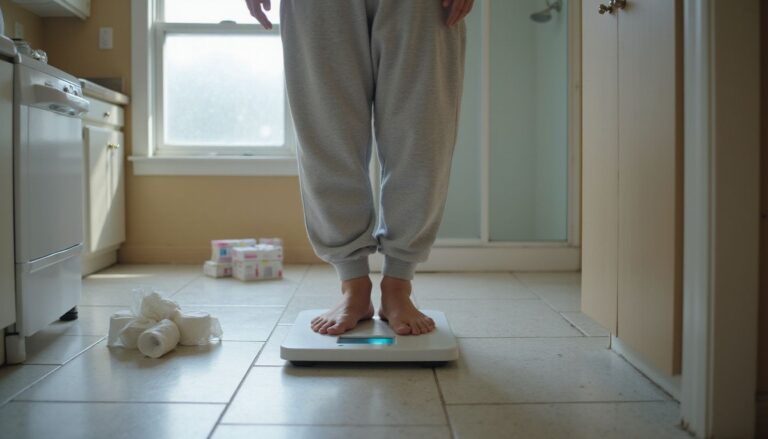Calorie Calculator: Walking To Lose Weight – Burn Calories And Shed Pounds!
Our Nutrition Assistant AI Suite will transform your body. You will lose fat, get toned, and build muscle. Gain confidence and optimal health.
You want to lose weight but feel unsure where to begin. A calorie calculator can turn every walk into clear, measurable progress. Walking is simple, joint friendly, and proven to help you burn calories and improve health.
This guide shows you how to estimate calories burned walking, set realistic goals, and build walking habits that last. Start today and let your daily steps work for you.
Key Takeaways
- Walk briskly 150 to 300 minutes per week, or reach 7,000 to 13,000 steps per day, to support weight loss and heart health.
- Calorie calculators estimate your burn using body weight, pace, time, incline, stride length, terrain, and any added resistance.
- Pair regular walking with dietary changes such as cutting added sugar and saturated fat for stronger fat loss results.
- Intervals and hills raise heart rate and muscle demand, which helps you burn more calories than steady, flat walks.
- Fitness watches and apps make tracking easier; guidelines also favor adding strength training for lasting success.

Why Walking Helps You Lose Weight

Walking is one of the most accessible ways to start a weight loss plan. The American College of Sports Medicine reports that structured walking workouts can help you burn meaningful calories and support a healthy weight.
How does walking burn calories efficiently?
Brisk walking recruits large muscles in your hips and legs, including the gluteus maximus and quadriceps. As speed or incline rises, your muscles demand more energy, so you burn more calories per minute.
A 165 pound person may burn about 500 calories across 10,000 steps at a moderate pace. A 110 pound person may burn around 290 calories over the same distance. Power walking or using a treadmill on an incline can lift your heart rate and increase exercise intensity, which boosts total calorie burn.
Hills challenge your lungs and legs more than flat ground. Wearing a light weighted vest adds resistance so your body works harder with each step.
Shorter, frequent walks can keep your metabolism active longer than one long stroll. Guidance from sports medicine suggests several daily sessions often produce higher total energy output than a single workout.
Try adding stairs or gentle hills to your route. Many walkers see steady weekly calorie deficits and consistent progress with these small changes.
How does walking boost metabolism?
Walking supports a higher metabolism in several ways. It helps you build or preserve muscle, which raises your basal metabolic rate, the calories you burn at rest.
Short speed bursts, known as intervals, and resistance like hills or a light vest raise workout intensity. This can increase calorie use during your walk and for a short time after you finish, a response called excess post-exercise oxygen use.
Public health guidance recommends pairing aerobic activity, such as brisk walks, with strength training to improve metabolic health. Moving at a faster pace also elevates heart rate, which strengthens cardiovascular fitness and supports healthy weight control.
Many walkers feel more energized after interval sessions. The temporary spike in metabolism can make even moderate activities, like longer walks, more effective for fat loss.
Mix speed changes, hills, or light strength moves. This variety helps you maintain higher daily calorie burn while improving muscle and resting metabolism.
How does walking improve overall health?
Regular walks help lower blood pressure and LDL cholesterol, two key heart risk factors. The Arthritis Foundation notes a lower risk of stroke among consistent walkers.
Research supported by the National Institutes of Health links daily walking to lower risk of cardiovascular disease and dementia. In older adults, more walking often relates to less cognitive decline with age.
Walking improves circulation and joint mobility, and it may reduce hip fracture risk. Many people also sleep longer and fall asleep faster on days they walk for an hour.
Staying active in midlife can reduce mortality rates. Walking also releases endorphins, which can lower stress and improve mood soon after you start moving.
How to Calculate Calories Burned While Walking
A calorie calculator can estimate calories burned by combining your weight, pace, and walking time. Many apps and pedometers record steps and speed so you can stay on track with your goals.
What factors affect calorie burn during walking?
Several factors shape the number of calories you burn while walking. Knowing these helps you plan smarter routes and sessions.
- Body weight: Moving more mass takes more energy, so heavier bodies burn more per step.
- Walking speed: A brisk pace, about 3 to 4 mph, burns more than an easy stroll.
- Walking incline: Uphill paths, or a positive slope on a treadmill, increase muscle activation and calorie use.
- Duration of walk: More minutes equals more total calories burned.
- Resistance use: A light weighted vest or small hand weights can raise intensity without adding time.
- Stride length: Longer steps cover more distance, which can increase energy use if effort stays consistent.
- Terrain type: Grass, gravel, or hilly ground forces your core and legs to stabilize, raising demand over smooth paths.
- Form and posture: Efficient mechanics help you walk faster safely, which supports better results.
Once you understand these variables, tools like an omni calculator or fitness app can give tighter estimates and track trends over time.
How do I use a calorie calculator?
Using a calculator is simple. The key is entering accurate, current data.
- Open a trusted tool, such as Omni Calculator, that includes a walking option.
- Choose treadmill or outdoor walking so incline or terrain is considered properly.
- Enter your weight in pounds or kilograms. Weight strongly affects calorie estimates and body mass index calculations.
- Set your average pace in miles per hour. If unsure, pick moderate, usually around 3 to 4 mph.
- Input your walking time, either per session or per week, to see total burn.
- Add incline details, such as uphill, downhill, or flat. Inclines typically increase calories used.
- Measure your stride length if the tool requests it. Some apps sync this from a fitness watch.
- Update your weight often as you progress. Changing weight alters your calorie burn per session.
- Connect your watch or phone app so steps and heart rate can refine estimates automatically.
- Review the results after each walk. Adjust time, pace, or incline to reach about 250 minutes per week of moderate activity or more if your goals allow.
Many walkers enjoy seeing the numbers after each session. It turns small choices into visible progress, which keeps motivation high.
How can I track my walking progress with apps or pedometers?
Tracking tools make progress easy to see. They collect steps, time, distance, and even pace.
- Use a fitness watch to count steps and estimate calories burned during every walk.
- Try GPS-based apps to map routes, measure miles, and record your pace.
- Sync data to a phone health app for clear charts and weekly trends.
- Turn on goal alerts to nudge you when you sit too long or fall behind.
- Check weekly summaries to spot low activity days and plan fixes.
- Pick a daily step target that fits your age and fitness, such as 7,000 to 13,000 steps for many adults.
- Enter your weight, height, age, and stride length so calorie estimates are more precise.
- Log meals if that helps you connect food intake with your activity.
- Share progress with friends or join a community for support and accountability.
- Track hunger cues to see whether regular walks steady your appetite and improve energy across the day.
A quick routine in the morning and evening can raise your daily total. Many people hit new bests once they start watching their numbers.
Recommended Walking Goals for Weight Loss
Clear goals make each walk count. Start small, then build step by step until the routine feels natural.
How many steps should I aim for each day?
Ten thousand steps per day is popular, yet benefits start lower. Many younger adults do well between 7,000 and 13,000 steps daily.
Older adults may aim for 6,000 to 10,000 steps. Research in older women found mortality benefits even above 4,400 steps per day.
If you sit much at work, long step goals may feel tough at first. Take stairs, add short walks during breaks, and park farther away to lift your total.
Fitness trackers turn step goals into a daily habit. Many people also find that watching steps naturally supports eating fewer calories than before.
What is the ideal daily walking duration?
Thirty minutes of brisk walking on most days is a strong target. At a pace where talking is possible but singing is hard, you may burn around 150 calories.
You can split this time. Two 25 minute walks can be more effective for weight loss than one 50 minute session in some studies.
Build up slowly and keep consistency front and center. Short daily walks that you enjoy beat occasional long ones that feel exhausting.
What are good weekly walking targets?
Weekly goals give structure to your plan. Use time or steps, then adjust as your fitness grows.
- Reach at least 150 minutes of moderate walking each week.
- For bigger changes, set 300 minutes or more as your next step.
- Plan 30 to 45 minutes most days, totaling 210 to 315 minutes weekly.
- Target about 10,000 steps daily, or roughly 70,000 per week.
- Use a tracker to record progress and guide small changes.
- Break targets into shorter walks if that fits your schedule.
- Increase time or distance slightly each week to keep improving.
- Pick goals that stretch you but still feel doable, then bump them up over time.
These goals match national activity guidelines and support steady weight control.
Tips to Maximize Calorie Burn While Walking
Small tweaks can raise your calorie burn without adding much time. Think of them as simple dials you can turn up or down.
Why should I walk briskly at a moderate pace?
Brisk walking increases heart rate and helps you burn more calories than strolling. It also improves cardiovascular fitness without beating up your joints.
A good rule is this, you can talk but not sing. Many adults burn about 150 calories in 30 minutes at this effort.
Moving briskly covers more ground in less time. That means extra calorie burn per session and better odds of hitting weekly goals.
Pacing up also feels energizing for many walkers. It can promote fat reduction because your body must work harder than during a casual walk.
How can power walking intervals increase calorie burn?
Intervals mix short bursts of fast walking with recovery at your normal pace. After a 5 to 10 minute warm up, add a 10 to 15 second surge, then return to moderate speed. Repeat this pattern for the middle of your session.
Arm drive during the fast parts raises total effort and energy use. Interval training can keep calorie burn slightly elevated for a short time after you finish.
You can scale intervals to your level. Start with very short bursts, then extend them as your fitness improves.
Quick guide:
- Warm up 5 to 10 minutes.
- Alternate 10 to 15 seconds fast with your normal pace.
- Use strong arm swings to increase intensity.
- Intervals raise heart rate and can lift calorie use during and after your walk.
- Short bursts suit beginners, longer ones suit experienced walkers.
What are the benefits of walking uphill or on an incline?
Hills and treadmill inclines increase workload, so you burn more calories per minute. They engage your calves, hamstrings, and glutes more than flat routes.
Inclines can break a weight loss plateau by adding intensity without extra time. Try two or three hill sessions weekly to build endurance and cardiovascular health faster.
Downhill segments burn fewer calories but can improve control and balance. Consider a loop with both uphill and downhill for variety.
How can I safely use a weighted vest?
Talk with your healthcare provider first if you have back, neck, or joint issues. Begin with a light vest and increase gradually. Do not exceed 10 percent of your body weight.
Make sure the vest fits snugly so it does not shift. Use it for part of your walk at first to manage soreness risk. Some studies suggest weighted vests during light activity may support bone health in postmenopausal women.
Keep posture tall and even. Extra weight should never pull you forward or strain your lower back.
Why is proper form and posture important when walking?
Good form keeps you efficient and reduces injury risk. Stand tall with head, shoulders, spine, and hips aligned.
Engage your abs and keep feet hip width apart. Land heel to toe while swinging bent arms close to your sides. Avoid leaning forward or backward, even on hills.
Strong posture helps activate more muscles and can increase calorie burn per minute. It also supports long term consistency because walking feels better when your form is smooth.
Combining Walking with Other Weight Loss Strategies
Walking works best as part of a simple plan. Pair it with smart eating and two short strength sessions each week for powerful results.
How can I pair walking with dietary changes?
Food choices affect your calorie deficit, the gap between calories in and calories out. Small upgrades add up fast when you walk most days.
- Track steps and food side by side to spot patterns that help or hurt progress.
- Build meals around fruits, vegetables, lean protein, and whole grains to cut excess calories naturally.
- Limit added sugar and saturated fat to support fat loss and heart health.
- Match intake to activity. Eat a bit more after long walks, a bit less on rest days.
- Plan snacks around walks to steady energy and avoid late overeating.
- Consider meeting a registered dietitian if you want a custom plan for your goals.
- Combining healthy eating and walking usually reduces body fat more than exercise alone.
Why add resistance training to your routine?
Strength work builds muscle, which raises your daily calorie burn. Aim to train major muscle groups twice per week.
Use a weight or band that brings fatigue in 12 to 15 reps. During or after a walk, try simple moves like squats, push ups, triceps dips, or lunges.
Over time, strength work supports bone density and helps prevent muscle loss during weight loss. It pairs well with walking for total health and lasting results.
How do flexibility exercises support walking and balance?
Flexibility work keeps joints moving well and reduces tightness that can change your gait. Stretch gently after walks, and warm up with easy range of motion before you start.
Practices like yoga or Pilates can improve posture and balance. Better flexibility helps you handle uneven surfaces safely and may reduce fall risk, especially in older adults.
Combining strength, aerobic work, and flexibility creates a well rounded plan. That balance supports progress and reduces injury risk.
Common Questions About Walking for Weight Loss
These answers blend research and practical steps. Use them to fine tune your plan and set clear expectations.
Can walking reduce belly fat?
Walking cannot spot reduce your midsection, but it can lower total body fat, including belly fat. Consistent walking plus calorie control often reduces waist size over time.
Brisk walks and higher daily steps are tied to less visceral fat. Aim for at least 150 minutes each week, then add intervals or hills to nudge results along.
Measure your waist monthly to track change beyond the scale. This gives a clearer view of body composition progress.
How much walking is needed to lose weight?
Most adults benefit from at least 150 minutes of moderate walking each week. That is 30 minutes on five days.
For larger changes, target 300 minutes weekly. Two shorter walks per day can help maintain a steady burn and fit busy schedules.
Many people aim for 10,000 or more daily steps if they sit much at work. Track your numbers and adjust time, pace, or incline based on results and your calorie intake.
Is walking alone enough for weight loss?
Walking helps a lot, but weight loss depends on your calorie balance. If you eat more than you burn, the scale may not move.
Combine walking with dietary changes for the strongest results. Add strength and flexibility training to protect muscle and support long term maintenance.
If progress stalls for several weeks, speak with a healthcare professional or dietitian. They can help you adjust your plan safely.
Benefits of Walking Beyond Weight Loss
Walking pays you back in many ways. These benefits support your health today and years from now.
How does walking improve cardiovascular health?
Regular walks can lower blood pressure and LDL cholesterol. Public health guidance suggests at least 30 minutes most days for a healthier heart.
Studies show walking helps prevent cardiovascular disease in different age groups. Hitting 7,000 to 13,000 steps per day may reduce stroke risk.
Using a step counter keeps you moving toward these targets. Many walkers notice steady fitness gains after just a few weeks.
How does walking strengthen lower body muscles?
Every step engages your legs and hips. Hills and inclines focus extra work on the glutes, hamstrings, and calves.
A light weighted vest increases resistance and muscle recruitment. Power walking raises intensity, which makes your hips and thighs work harder than a slow stroll.
Use a tall posture and a heel to toe roll to tone safely. Longer distances or higher intensities build endurance across your lower body.
Short strength intervals during or after walks can further improve leg strength. Over time, stronger muscles help keep metabolism higher all day.
Can walking reduce stress and boost mood?
Walking triggers endorphins, your body’s feel good chemicals. Even 10 minutes can improve your mood.
People who walk regularly tend to have lower rates of anxiety and depression. Outdoor walks add sunlight exposure, which supports sleep and stable energy.
Nature paths and social walks often bring extra mental benefits. They can make stress easier to handle.
How does walking promote long-term fitness habits?
Walking fits into daily life more easily than many workouts. Short, frequent walks around work or home add up fast.
Trackers and apps reinforce the habit by logging steps and celebrating milestones. Community groups build social support so you stay consistent.
Regular walking also helps prevent weight regain. It is safe for most adults and encourages steady, sustainable activity.
Walking for Different Fitness Levels
Whatever your starting point, you can make walking work for you. A good plan matches your current fitness and grows with you.
How should beginners start and build up walking?
- Begin with 10 to 15 minute walks at a comfortable pace, 2 to 3 times weekly.
- Keep posture tall, shoulders relaxed, and arms swinging naturally.
- Add about 5 minutes each week until you reach 30 minutes on most days.
- Use a simple step counter. Start with 3,000 to 5,000 steps per day, then build toward 7,500 or more.
- Wear supportive shoes and choose flat routes at first.
- Plan rest days or cross train with gentle cycling or swimming.
- Consult your clinician before starting if you have heart, bone, or joint concerns.
- Celebrate small wins to build confidence in the first month.
- Track distance, speed, and estimated calories to watch progress.
- Prioritize frequent short walks. Frequency builds endurance safely.
These steps help beginners raise activity without burnout or injury.
How can intermediate walkers add intensity and variety?
- Use hills or treadmill inclines to engage more muscle and lift calorie burn.
- Try a weighted vest set to 5 to 10 percent of your body weight.
- Add intervals with 30 to 120 second fast segments, followed by equal recovery.
- Do bodyweight moves like squats or lunges mid-walk or after cooldown.
- Rotate routes with varied terrain, such as grass, gravel, or sidewalks.
- Target 7,000 to 13,000 steps daily to support weight loss.
- Increase weekly distance or add a second short walk most days.
- Monitor pace and heart rate to stay in moderate to vigorous zones.
These upgrades keep training fresh and help you continue progressing.
What are advanced goals for steps and distance?
- Set a baseline of 10,000 or more steps daily if you sit much at work.
- Accumulate 300 or more minutes of walking per week.
- Join community events or challenges to boost commitment.
- Use your tracker to break personal bests each week.
- Add structured intervals, such as 1 minute fast with 1 minute easy, several times weekly.
- Schedule hill sessions on varied terrain to recruit more muscles.
- Extend walk distance gradually, working past five miles as stamina improves.
- Pair higher steps with strength moves for legs and core.
Advanced targets raise endurance, speed, and calorie burn while keeping your plan engaging.
Tools to Support Your Walking Journey
Right tools make it easier to plan, track, and improve. Pick options that fit your budget and routines.
What are the best fitness trackers and pedometers?
- Garmin watches track steps, calories, heart rate, and routes with GPS. Some models provide move alerts.
- Apple Watch tracks steps, calories, distance, and pace, then syncs with health apps for deeper insights.
- Fitbit offers reliable step counting at a friendly price point, with heart rate on many models.
- Simple pedometers count steps without apps or extras, a good budget choice.
- Check battery life and comfort so long walks go uninterrupted.
- Many trackers sync with nutrition apps to view calories burned next to food intake.
- On-wrist goals and weekly charts keep motivation front and center.
A basic clip-on step counter can still be great on long hikes or city walks. It keeps you focused on daily movement without distractions.
Which walking apps have calorie calculators?
- MapMyWalk estimates calories using pace, distance, and weight, and it logs routes.
- Pacer counts steps and provides simple calorie estimates with a clean interface.
- Strava uses GPS to track pace and distance, then estimates calories and summarizes each activity.
- Walkmeter offers detailed route data and personalized calorie estimates.
- Fitbit’s app syncs with wearables and displays calories from all activities, including walks.
- Google Fit shows steps and calories based on logged movement.
- Samsung Health tracks steps, calories, and trends over time on supported devices.
Pick one app and stick with it for several weeks. Consistent tracking beats constant switching.
How can community walking groups help?
Walking with others builds accountability and confidence. Group energy makes it easier to hit daily step goals and try new routes.
Many groups include brisk intervals or hill segments during sessions. These raise calorie burn and improve cardiovascular fitness.
Seeing shared progress in an app or spreadsheet can be very motivating. People often walk farther and more often with support from friends or neighbors.
Staying Motivated to Walk Regularly
Motivation grows when you see progress and enjoy the process. Build a routine that gives quick wins and steady rewards.
How do I set achievable walking goals?
- Start with at least 150 minutes of moderate walking per week, about 30 minutes on most days.
- Break big goals into smaller steps, such as moving from 5,000 to 7,000 steps, then toward 10,000.
- Use a tracker to see real-time progress. People usually walk more when they measure it.
- Shape goals around your schedule, for example five 30 minute sessions weekly.
- Add small challenges, like a short hill or a light vest, once your base is solid.
- Reward milestones with non-food treats, like a new hat or a favorite activity.
- Invite friends or join a walking group for support and accountability.
What are good ways to reward milestones?
- Buy new walking shoes or gear when you hit a step or distance goal.
- Enjoy a healthy meal out after a full month of consistent walks.
- Plan a fun outing, like a movie or park visit, after two weeks at 10,000 steps a day.
- Set aside time for self-care, such as a bath or a favorite book, after a strong week.
- Share progress with friends and meet for a celebratory walk at month’s end.
- Create a new playlist or choose an audiobook after a 50,000 step week.
- Mark a calendar with stickers for each goal day. Visual wins can fuel momentum.
- Take photos at scenic spots during milestone walks to capture your journey.
How can making walking social increase motivation?
Walking with friends or family boosts commitment and enjoyment. You get encouragement, conversation, and healthy competition.
Group walks often last longer than solo walks. In one study, people walked much more with company compared to walking alone.
Set standing meetups to create routine. Friendly challenges can help everyone reach new bests while keeping the mood positive.
Conclusion
A calorie calculator turns your walking workout into clear numbers you can act on. Brisk walks, power intervals, hills, or a light weighted vest can help you burn more calories in the same amount of time.
Pair consistent walking with simple dietary changes for stronger fat loss. Track steps with a pedometer or app so goals stay visible and progress stays steady. If you have a medical condition, talk with a healthcare professional before changing your exercise or nutrition.
Small steps add up quickly. Stay consistent, and your daily walks can help you lose weight, protect your heart, and feel better day after day.
FAQs
1. How does a calorie calculator help with weight loss when walking?
A calorie calculator estimates the energy you use while walking based on your body mass, pace, and time spent moving. This helps you plan walks that match your weight loss goals by showing how many calories you burn each session.
2. What factors affect the number of calories burned during a walk?
The main factors include your body mass, speed, distance covered, and terrain type. For example, brisk movement or uphill routes increase energy use compared to slow strolls on flat ground.
3. Can regular walking alone lead to shedding pounds?
Consistent daily walks can support fat reduction if combined with healthy eating habits. Research shows that moderate activity like brisk movement for 30 minutes most days aids in creating an energy deficit needed for losing excess fat (Harvard Health Publishing).
4. Is there personal evidence supporting calorie calculators for tracking progress?
After using a calorie calculator to log my own steps and meals over several weeks, I noticed steady changes in my scale readings and waist size as I adjusted my routines based on feedback from the tool.
Summary: Calorie calculators provide clear data about how much energy is used during physical activity such as walking; this information supports effective planning for those aiming to lose extra pounds through consistent exercise and mindful nutrition choices.







